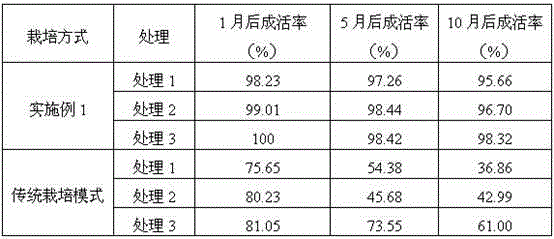Method for cultivating wild anoectochilus formosanus
A cultivation method and technology for seedlings are applied in the field of cultivation of wild clematis, which can solve the problems of insufficient management, difficulty in solving, being susceptible to field diseases and insect pests, etc., so as to reduce the damage caused by diseases and insect pests, improve the yield and quality, and improve the safety factor. Effect
- Summary
- Abstract
- Description
- Claims
- Application Information
AI Technical Summary
Problems solved by technology
Method used
Image
Examples
Embodiment 1
[0043] The inventor tried to cultivate wild clematis in the vicinity of Qinzhou City, Guangxi from 2011 to 2013. The area of the plot is about 400m 2 , the shed is 4m wide, and the surrounding traffic is developed. It belongs to the depression terrain. There are eucalyptus forests planted on the surrounding hills. The temperature range is 22-28 ℃ all year round, and the humidity is relatively high. It used to be wasteland, which belongs to laterite soil and is rich in phosphorus. First, a greenhouse was constructed on the plot:
[0044] a. The entire shed is supported by cement columns. The length of the cement columns is 1m, 1.5m and 2m. Concrete supports are built on the outermost side and the middle of the shed respectively, and then half-moon iron pipes are used as supports to support the shed surface at intervals of 2m. The distance is fixed side by side to form a shed. After the support is built, cover the transparent agricultural film on the shed surface and fix it. T...
Embodiment 2
[0068] Example 2: Effectively improved the survival rate and quality with the above method of cultivating wild clematis:
[0069] Comparison of the Survival Rate of Wild Anologia clematis Cultivated Using the Above-mentioned Cultivation Method and the Traditional Method
[0070]
[0071] It can be seen that the cultivation method of the present invention can ensure that the survival rate of clematis is as high as more than 95%, while the traditional cultivation mode is unstable and the survival rate is low. Continuous planting experience for many years shows that: the cultivation method of the wild clematis is completely The need for large-scale production of clematis can be realized. After testing by relevant departments, the medicinal ingredients of the cultivated and bred clematis have all reached the qualified standard.
PUM
 Login to View More
Login to View More Abstract
Description
Claims
Application Information
 Login to View More
Login to View More - R&D
- Intellectual Property
- Life Sciences
- Materials
- Tech Scout
- Unparalleled Data Quality
- Higher Quality Content
- 60% Fewer Hallucinations
Browse by: Latest US Patents, China's latest patents, Technical Efficacy Thesaurus, Application Domain, Technology Topic, Popular Technical Reports.
© 2025 PatSnap. All rights reserved.Legal|Privacy policy|Modern Slavery Act Transparency Statement|Sitemap|About US| Contact US: help@patsnap.com


